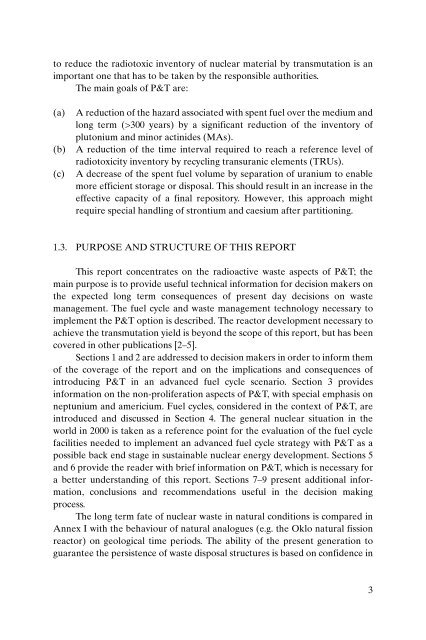TRS435_web
TRS435_web
TRS435_web
You also want an ePaper? Increase the reach of your titles
YUMPU automatically turns print PDFs into web optimized ePapers that Google loves.
to reduce the radiotoxic inventory of nuclear material by transmutation is an<br />
important one that has to be taken by the responsible authorities.<br />
The main goals of P&T are:<br />
(a)<br />
(b)<br />
(c)<br />
A reduction of the hazard associated with spent fuel over the medium and<br />
long term (>300 years) by a significant reduction of the inventory of<br />
plutonium and minor actinides (MAs).<br />
A reduction of the time interval required to reach a reference level of<br />
radiotoxicity inventory by recycling transuranic elements (TRUs).<br />
A decrease of the spent fuel volume by separation of uranium to enable<br />
more efficient storage or disposal. This should result in an increase in the<br />
effective capacity of a final repository. However, this approach might<br />
require special handling of strontium and caesium after partitioning.<br />
1.3. PURPOSE AND STRUCTURE OF THIS REPORT<br />
This report concentrates on the radioactive waste aspects of P&T; the<br />
main purpose is to provide useful technical information for decision makers on<br />
the expected long term consequences of present day decisions on waste<br />
management. The fuel cycle and waste management technology necessary to<br />
implement the P&T option is described. The reactor development necessary to<br />
achieve the transmutation yield is beyond the scope of this report, but has been<br />
covered in other publications [2–5].<br />
Sections 1 and 2 are addressed to decision makers in order to inform them<br />
of the coverage of the report and on the implications and consequences of<br />
introducing P&T in an advanced fuel cycle scenario. Section 3 provides<br />
information on the non-proliferation aspects of P&T, with special emphasis on<br />
neptunium and americium. Fuel cycles, considered in the context of P&T, are<br />
introduced and discussed in Section 4. The general nuclear situation in the<br />
world in 2000 is taken as a reference point for the evaluation of the fuel cycle<br />
facilities needed to implement an advanced fuel cycle strategy with P&T as a<br />
possible back end stage in sustainable nuclear energy development. Sections 5<br />
and 6 provide the reader with brief information on P&T, which is necessary for<br />
a better understanding of this report. Sections 7–9 present additional information,<br />
conclusions and recommendations useful in the decision making<br />
process.<br />
The long term fate of nuclear waste in natural conditions is compared in<br />
Annex I with the behaviour of natural analogues (e.g. the Oklo natural fission<br />
reactor) on geological time periods. The ability of the present generation to<br />
guarantee the persistence of waste disposal structures is based on confidence in<br />
3


